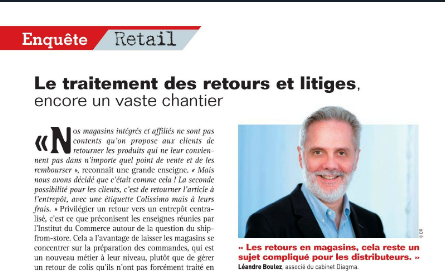Supply Chain Magazine interviewed Olivier Dubouis, Partner and Managing Director of DIAGMA and Léandre Boulez, Partner of DIAGMA as part of a Survey entitled: “Stores undergoing omnichannel transformation” published in the September 2022 issue.
 Léandre Boulez, Associé DIAGMA interviewé par Supply Chain Magazine sur la gestion des retours en magasins.
Léandre Boulez, Associé DIAGMA interviewé par Supply Chain Magazine sur la gestion des retours en magasins. Stores are undergoing an omnichannel transformation. Due to their number and their local presence, they play an essential role in omnichannel distribution. In fact, in addition to being a place of sale, they are a local storage point and can quickly serve available products ordered on the net. They are also a place of services: information, collection, after-sales service, product returns… A link increasingly integrated into omnichannel distribution, the success of their transformation is conditioned by multiple parameters… Olivier Dubouis, and Léandre Boulez , DIAGMA Partners, interviewed by Supply Chain Magazine mention some of them.
Efficient starting point for expensive and bulky products
“In DIY, for example, anything that is cheap and rather bulky, like concrete blocks, has no interest in being stored in a central warehouse. The supply is essentially local. And it would cost too much to transport over long distances. Delivery to the customer should be as short as possible. So the store is an effective starting point,” analyzes Léandre Boulez, Partner at DIAGMA.
Put high-rotation products in stores
“What also matters is the turnover rate of the product. The lower it is, the more the product must be upstream of the network to optimize stocks and maximize the chances of selling it. And so, the stronger it is, the more it is present in the store, nearby,” adds Olivier Dubouis, Partner and Managing Director of DIAGMA
High in-store picking costs
Omnichannel remuneration rule: “I attribute the turnover to the store that carries the sale and therefore holds the stock. But there are still few brands that ship from stores. Leaving the warehouse often costs more than leaving the warehouse due to much lower picking-packaging-shipping productivity,” explains Léandre Boulez.
Difficulties in managing in-store returns
About returns: “Returns to stores remain a complicated subject for distributors,” say Olivier Dubouis and Léandre Boulez, Partners at DIAGMA. “Who decides on re-marketing? In the store itself? Elsewhere ? Local resale rates may be low. The product may not (or no longer) be in the assortment of the store. And the store is not always equipped to restore it to salable condition.”
